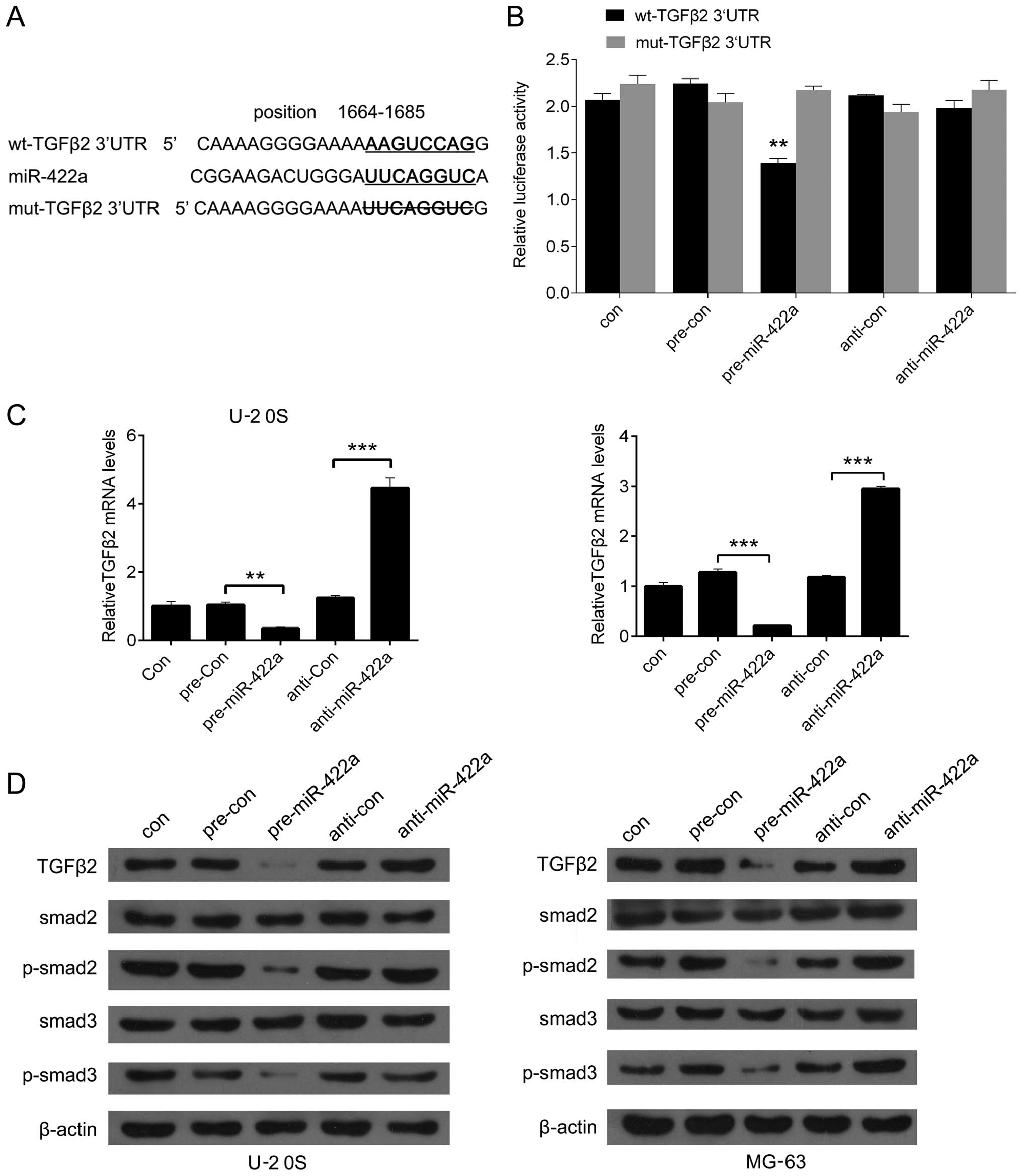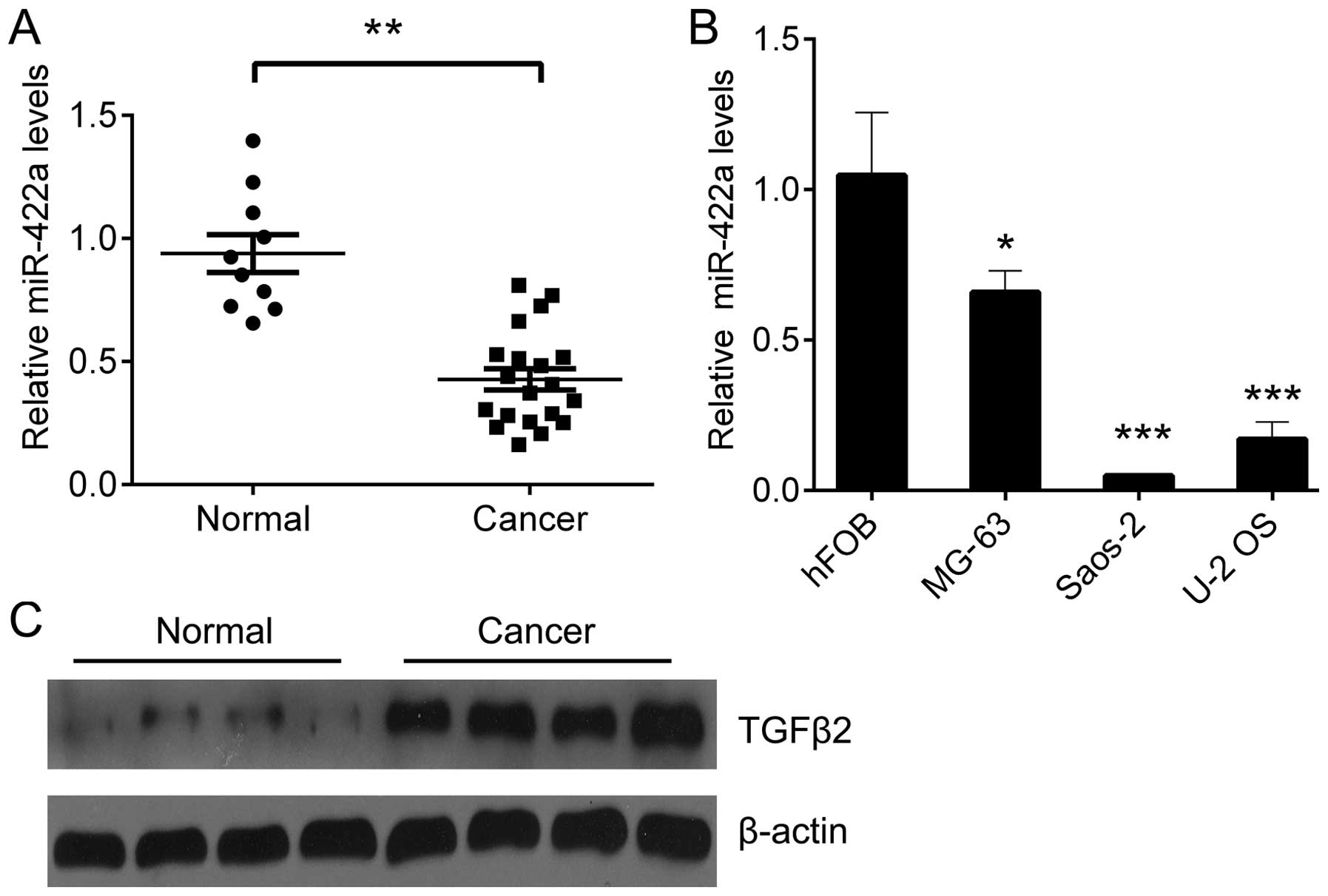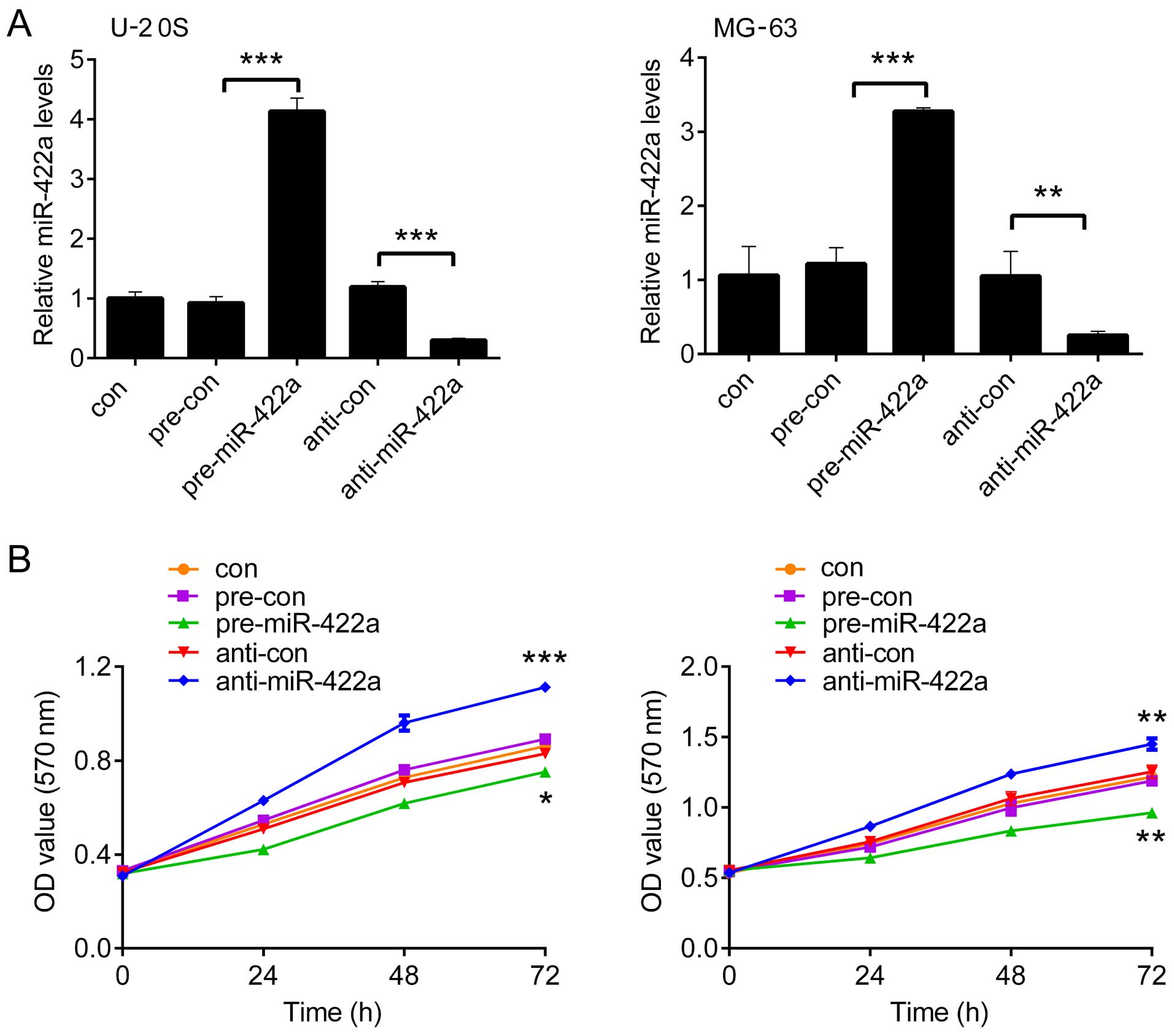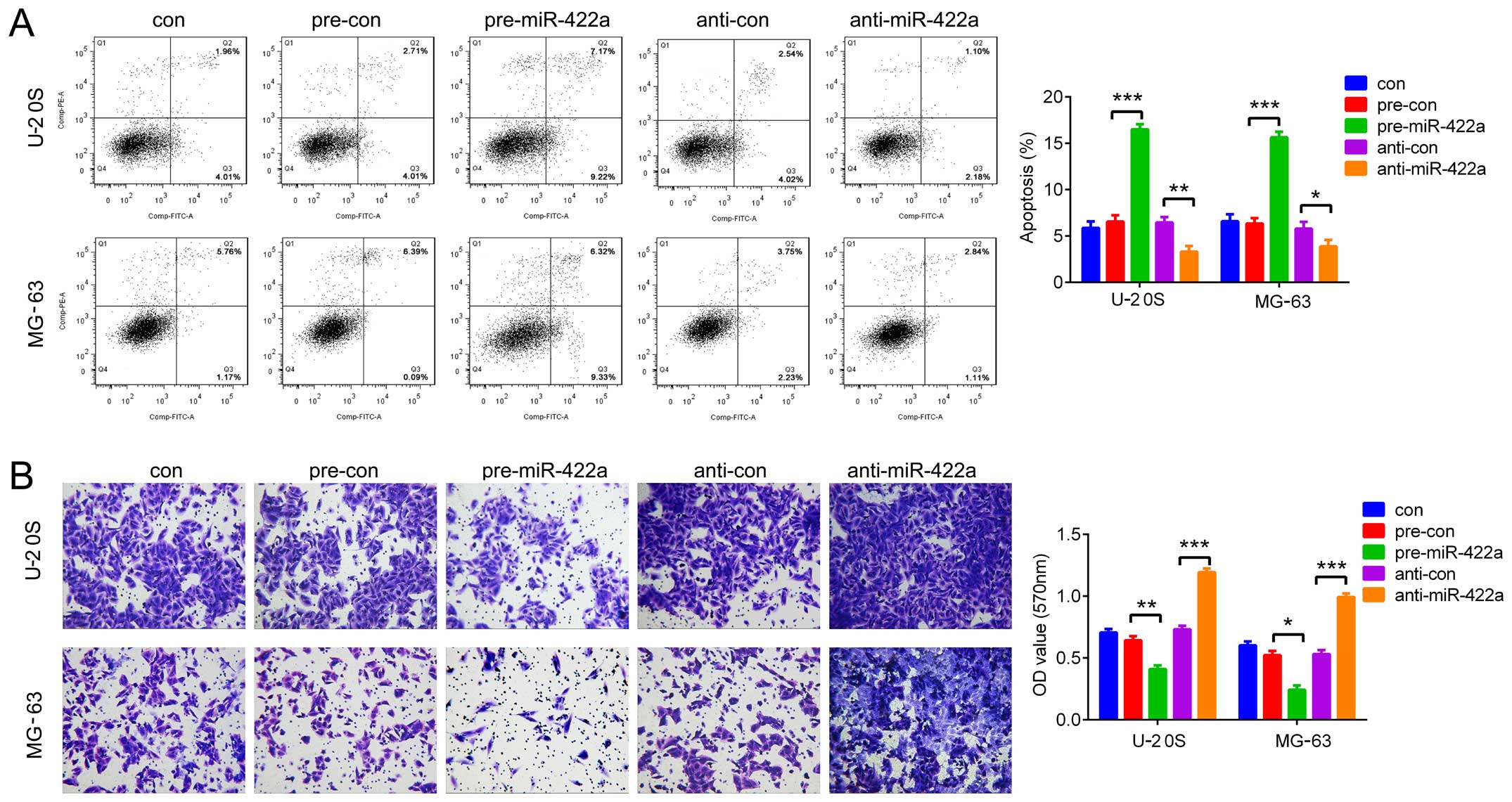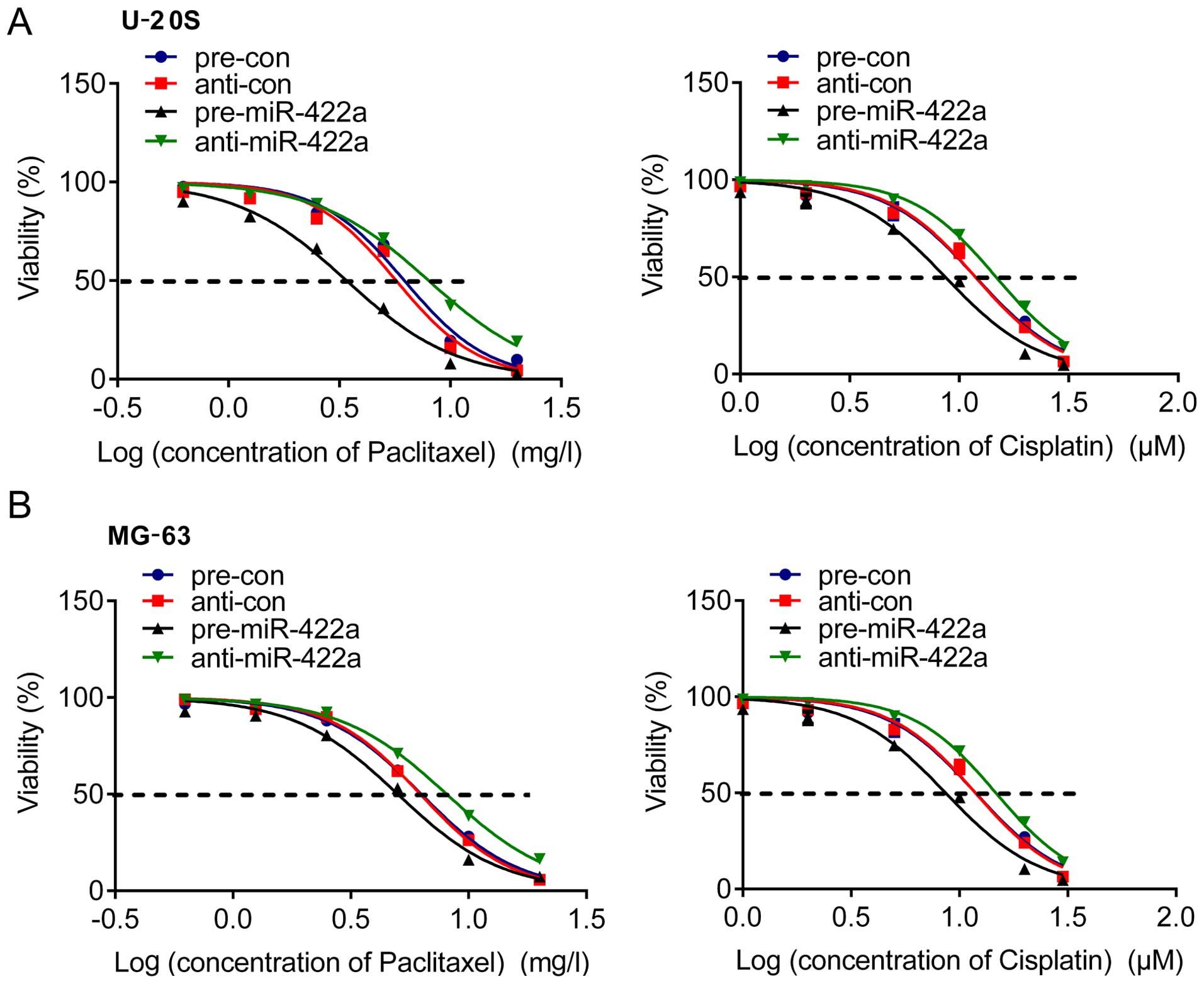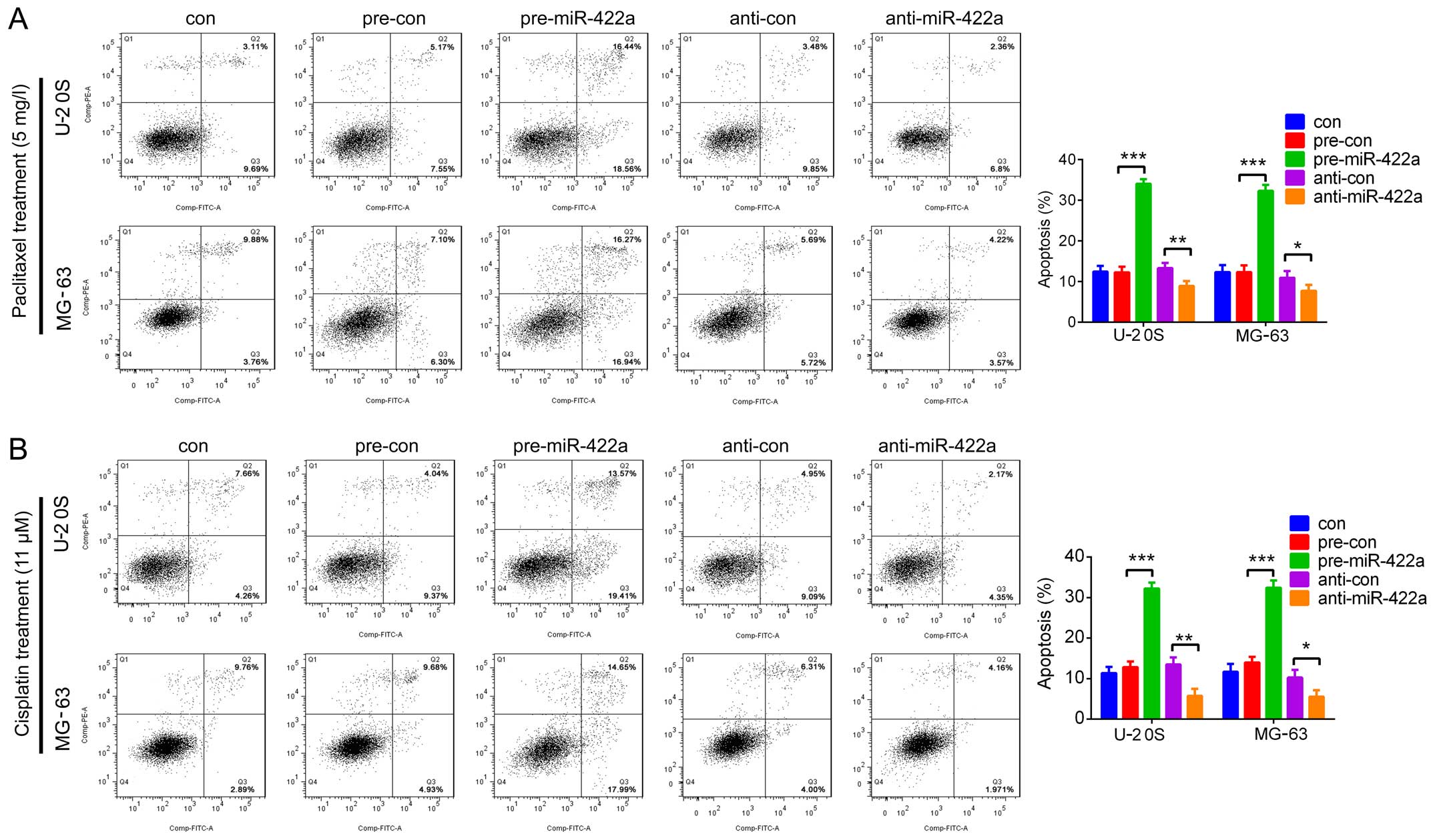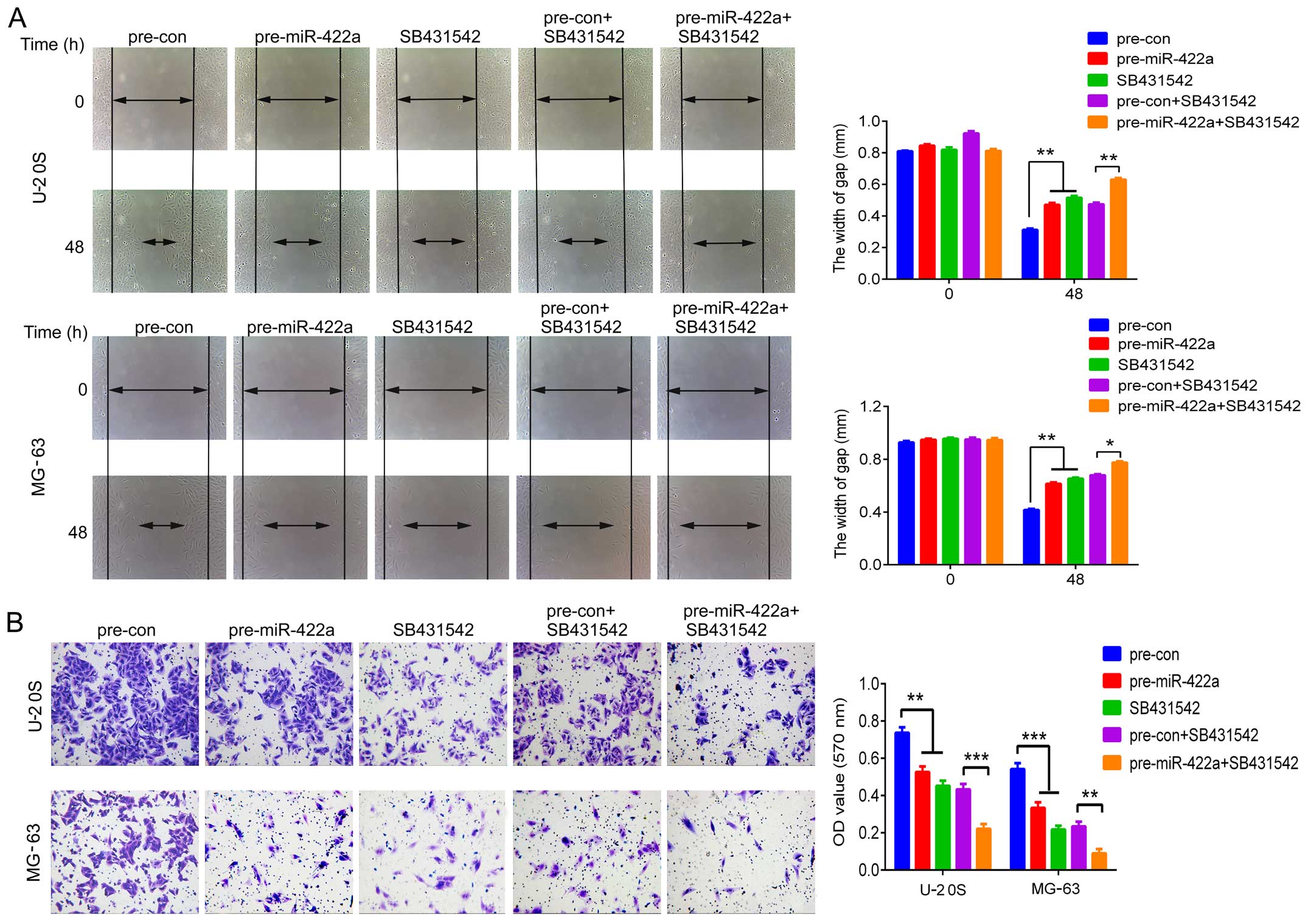Introduction
Osteosarcoma (OS) is an aggressive malignant tumor
that is mesenchymal in origin, which is of particular importance to
children and adolescents as ~60% of cases are pediatric patients
(1). OS is characterized by highly
complex heterogeneous tumor, by vast genomic instability and by
multiple genomic aberrations at multiple chromosomes (2). Although the treatments, including
surgery, radiation, chemotherapy and combination of them are
improved, the 5-year survival rate of patients with OS remains low,
particularly in the patients with locally advanced or metastatic
tumors, and recurrent disease (3).
Thus, it is an urgent need to identify novel and targetable
biomarkers for better diagnosis and prognosis of OS.
MicroRNAs (miRNAs) are a class of small non-coding
RNA molecules, ranging between 18–25 nucleotides in length. They
post-transcriptionally regulate target genes expression by binding
at the 3′ untranslated region (3UTR) (4). Each miRNA can control hundreds of gene
transcripts. miRNAs play a critical role in essential biological
processes such as cellular proliferation, differentiation and
apoptosis in normal or cancer cells, including OS cells (5). miRNAs function as tumor suppressors or
oncogenes depending on their target genes. Over the past few years,
dysregulation of miRNAs has been implicated in pathogenesis and
clinical relevance of OS (6). For
example, Zhang et al found that miR-874 was significantly
downregulated in OS cell lines and clinical specimens, and acted as
an independent predictor of poor survival, which was associated
with tumor size, distant metastasis and advanced clinical stage
(7). miR-421 expression levels were
upregulated in OS tissue and serum, and it may be a marker for
diagnosis of OS (8). Recently, Niu
et al found that transforming growth factor-β2 (TGFβ2) was
negatively regulated by miR-153, and overexpression of miR-153
decreased the expression of phosphorylated SMAD2 and SMAD3, the
downstream molecules of TGF-β in OS cell line MG-63 (9). miR-422a has been found to be
tumor-suppressor in hepatocellular carcinoma (10). Furthermore, miR-422a was identified
as discriminating miRNA in patient with OS, which could be easily
transferable to diagnosis and may be a potent diagnostic tool to
predict tumor sensitivity to chemotherapy drugs (11). The expression level of miR-422a was
strongly decreased in OS bone tissue compared with non-cancerous
bone tissues, which was associated with tumor size, advanced TNM
stage, distant metastasis, grade of tumor and shorter overall
survival time (12). However, the
role of miR-422a in OS and the mechanisms by which miR-422a
controls cell proliferation and apoptosis remain unknown.
In the present study, we aimed to investigate the
role of miR-422a in OS. We analyzed the expression of miR-422a in
OS tissues and cell lines. By gain and loss function experiments,
we demonstrated that miR-422a was able to enhance paclitaxel and
cisplatin induced apoptosis and functioned as a tumor suppressor in
OS by directly targeting TGFβ2. Thus, we provide evidence to show
that miR-422a may be potential therapy target for OS treatment.
Materials and methods
OS tissue samples
Ten adjacent tumor and 20 OS tissues, and another 4
paired cancer and adjacent tissues, were collected from Hunan
Cancer Hospital. Informed consents have been signed by all
subjects. All samples were collected and identified by
histopathological evaluation, and stored at −80°C until used.
Cell culture
Human OS cell lines MG-63, Saos-2 and U-2 0S, and
normal human fetal osteoblast hFOB cells were obtained from the
American Type Culture Collection (ATCC; Manassas, VA, USA). All the
cells were cultured in Dulbeccos modified Eagles medium (DMEM),
supplemented with 10% (v/v) fetal bovine serum (FBS), 100 U/ml
penicillin/streptomycin (all from Invitrogen Life Technologies,
Carlsbad, CA, USA) at 37°C in a humidified 5% CO2
incubator.
Cell treatment
To knock down or overexpress the expression of
miR-422a, the cells were transfected with pre-miR-422a or
anti-miR-422a using Lipofectamine 2000 (Life Technologies)
according to the manufacturer's instructions. The cells transfected
with scramble inhibitor or mimics were used as negative
control.
To suppress TGFβ/smad signaling, TGFβ inhibitor
SB431542 (0.3 µM; Sigma-Aldrich, St. Louis, MO, USA) was added to
the cultured medium.
Quantitative PCR (qPCR) analysis
TRIzol reagent (Invitrogen, Carlsbad, CA, USA) was
used to extract total RNA from the indicated cells according to the
manufacturer's instructions. SYBR-Green qRCR mix (Toyobo, Shanghai,
China) was used for real-time PCR to detect mRNA levels. The
primers were as follows: TGFβ2 sense, AGCAAGCT GAAGCTCACCAGT and
antisense, TTGGCGTAGTACTCT TCGTCG; β-actin sense,
AGGGGCCGGACTCGTCATACT and antisense, GGCGGCACCACCATGTACCCT. miRNA
qRT-PCR Starter kit (RiboBio, Guangzhou, China) was used for
real-time PCR to detect miR-422a levels. The primers of miR-422a
(HmiRQP0490) and U6 were purchased from FulenGen (Guangzhou,
China). The expression of target genes was normalized by β-actin or
U6. All the qPCR data were processed using 2−ΔΔCt
method.
Western blot analysis
The protein was extracted by RIPA lysis buffer
(Auragene, Changsha, China) from indicated cells, and Bradford
protein assay kit (Beyotime Biotechnology, Shanghai, China) was
used to measure the protein concentration. After separated on 10%
SDS-PAGE gels, the protein was transferred to nitrocellulose
membranes. The membranes were blocked with 5% non-fat dry milk and
incubated with primary antibodies mouse monoclonal anti-TGFβ2 (cat
no. ab36495; dilution: 1:1,000), rabbit polyclonal anti-smad2 (cat
no. ab17812; dilution: 1:1,000) and rabbit polyclonal anti-smad3
(cat no. ab122028; dilution: 1:1,000) were purchased from Abcam
(Cambridge, UK), goat polyclonal anti-phosphorylated smad3 and
phosphorylated smad2 (1:500) from Santa Cruz Biotechnology (Dallas,
TX, USA), mouse monoclonal anti-β-actin (1:5,000) from
Sigma-Aldrich overnight at 4°C. The membranes were washed with
Tris-buffered saline with Tween-20 (TBST), and were then incubated
with appropriate horseradish peroxidase (HRP)-conjugated secondary
antibody. Enhanced chemiluminescence (ECL) reagent was used to
detect the signal on the membrane.
Dual-luciferase report system
Wild-type (wt) and mutant (mut) 3'UTR of TGFβ2 were
designed by FulenGen, which was inserted into the downstream of
dual-luciferase reporter vector, and the mutant sites are shown in
Fig. 6A. For luciferase assay,
5×104 cells were plated and cultured into 24-well plates
to reach ~70% confluency. U-2 0S cells were co-transfected with
miR-422a mimics or miR-422a inhibitors and wt/mut 3'UTR of TGFβ2
dual-luciferase reporter vector, respectively. After 48 h
transfection, the luciferase activity was detected using
Dual-Luciferase reporter gene assay kit on luminometer (E9031)
(both from Promega, Madison, WI, USA).
MTT assay
Cell growth was measured by MTT assay. Indicated
cells (2,000) were seeded in each 96-well plate for 12 h, and
further incubated for 0, 24, 48 and 72 h, respectively. One hour
before the end of incubation, 100 µl MTT at 5 mg/ml final
concentration were added to each well for 4 h at 37°C. Then, the
supernatant were removed and 150 µl dimethyl sulfoxide (DMSO) was
added to each well for 15 min, and optical density (OD) 570 nm
value in each well was determined by an enzyme immunoassay
analyzer.
Flow cytometric analysis of
apoptosis
Cells from each group were trypsinized and washed
with cold phosphate-buffered saline (PBS), and Annexin V-FITC/PI
(KeyGen, Nanjing, China) were then used to stain the apoptotic
cells according to the manufacturer's instructions. The apoptosis
rate was analyzed by flow cytometry (MoFlo XDP; Beckman Coulter,
Brea, CA, USA). The experiments were independently performed in
triplicate.
Transwell assay
The indicated cells were starved for 24 h, and then
resuspended in serum-free medium and added to the upper chamber of
Transwell (Becton-Dickinson Company, Franklin Lakes, New Jersey,
USA). The lower chamber was filled with completed medium containing
10% FBS. Following 48 h culture, cells attached to the bottom were
fixed and stained with crystal violet for 30 min. The OD at 570 nm
of crystal violet dissolved by 10% acetic acid was detected by an
enzyme immunoassay analyzer (MK3; Thermo Fisher Scientific,
Waltham, MA, USA).
Statistical analysis
Statistical analyses were performed using GraphPad
Prism 5 software (Graphpad Software, Inc., La Jolla, CA, USA) and
the data are presented as the mean ± standard deviation. An
unpaired two-tailed Student's t-test or one way analysis of
variance (ANOVA) with Bonferroni post hoc test was used to analyze
the data depending on conditions. P<0.05 was considered to
indicate a statistically significant difference.
Results
The expression of miR-422a, TGFβ2 in
OS tissues and cell lines
To investigate the role of miR-422a in OS, we
collected 20 OS and 10 adjacent tissues to detect the expression of
miR-422a using qPCR. Our data showed that the average expression
level of miR-422a was significantly downregulated in OS tissue
samples compared with adjacent controls (Fig. 1A). In addition, similar results were
observed in the human OS cell lines, the expression of miR-422a in
OS cell lines was lower than in hFOB cells (Fig. 1B). In addition, we also analyzed the
expression of the putative targets of miR-422a, TGFβ2 in OS tissue
samples. We found that the protein levels of TGFβ2 were
significantly upregulated in 4 paired OS and normal adjacent
tissues (Fig. 1C). These results
indicate that miR-422a and TGFβ2 play an important role in OS.
The effects of miR-422a on cell
proliferation and invasion in U-2 0S and MG-63 cells
To investigate the role of miR-422a in OS, we
overexpressed or knocked down the expression of miR-422a in U-2 0S
and MG-63 cells (Fig. 2A). We found
that overexpression of miR-422a inhibited cell proliferation, while
downregulation of miR-422a promoted cell proliferation in U-2 0S
and MG-63 cell lines (Fig. 2B). In
addition, upregulation of miR-422a significantly increased
apoptosis, whereas downregulation of miR-422a exhibited an opposite
role (Fig. 3A). Furthermore, we
also accessed the role of miR-422a in cell invasion. Transwell
assay was used to analyze cell invasion after overexpression or
knockdown of miR-422a. Upregulation of miR-422a significantly
reduced invasion ability compared with the negative control, while
knockdown of miR-422a was able to enhance the ability of cell
invasion in U-2 0S and MG-63 cell lines (Fig. 3B). Thus, miR-422a functions as a
tumor suppressor in OS.
miR-422a sensitize OS cells to
paclitaxel and cisplatin
Furthermore, we investigated whether miR-422a had
synergic effects with current chemotherapy drug used in OS. We
found that overexpression of miR-422a significantly decreased the
IC50 values of paclitaxel (3.4 vs. 6.2 mg/l) and
cisplatin (8.6 vs. 11.9 µM) compared with negative control, while
downregulation of miR-422a significantly increased the
IC50 values of paclitaxel (6.2 vs. 8.0 mg/l) and
cisplatin (14.7 vs. 11.8 µM) compared with negative control in U-2
0S cells (Fig. 4A). Similar results
were also observed in MG-63 cells (Fig.
4B). The IC50 values of paclitaxel and cisplatin
were decreased from 6.3 to 5 mg/l, and from 11.5 to 7.9 µM,
respectively, in MG-63 cells overexpressing miR-422a. In contrast,
the IC50 values of paclitaxel and cisplatin were
increased from 6.2 to 8.1 mg/l, and from 11.2 to 17.4 µM,
respectively, by downregulation of miR-422a in MG-63 cells. In
addition, upregulation of miR-422a significantly enhanced
paclitaxel and cisplatin-mediated apoptosis in U-2 0S and MG-63
cells, whereas downregulation of miR-422a exhibited an opposite
role (Fig. 5). Thus, miR-422a is
able to sensitize OS cells to chemotherapy drugs paclitaxel and
cisplatin.
miR-422a regulates TGFβ2 expression at
transcriptional and translational levels by directly targeting its
3'UTR
To further investigate the downstream molecules
targeted by miR-422a, we screened the putative targets of miR-422a
using bioinformatic tool (http://www.microrna.org) and found that miR-422a
conversely targeted to TGFβ2. We performed dual-luciferase report
gene assay in U-2 0S cells to confirm whether the 3'UTR of TGFβ2
had a direct target site for miR-422a. The sequences that
containing the wt or mut 3'UTR of TGFβ2 were constructed into
dual-luciferase reporter gene (Fig.
6A). We found that the luciferase activity was significantly
repressed in the pre-miR-422a transfectant compared with the
negative control transfectant. Moreover, miR-422a-mediated
repression of luciferase activity was abolished by the mutant type
3'UTR of TGFβ2 (Fig. 6B). Moreover,
the mRNA and protein levels of TGFβ2 were markedly downregulated by
pre-miR-422a transfection, and upregulated by anti-miR-422a
transfection compared with the negative control, respectively.
These results determine that miR-144 directly targets TGFβ2 and
regulates its expression at transcriptional and translational
levels. Furthermore, we tested the downstream molecules of TGFβ2
smad2 and smad3 by western blotting in U-2 0S and MG-63 cells after
miR-422a knockdown or overexpression. Although overexpression and
knockdown of miR-422a did not alter the expression of total
smad2/3, a significant decrease of phosphorylated smad2 and smad3
were observed in U-2 0S and MG-63 cells with upregulated miR-422a;
and knockdown of miR-422a significantly increased the expression of
phosphorylated smad2 and smad3 compared with the negative control
(Fig. 6D). Moreover, we inhibited
the TGFβ2/smad signaling using TGFβ2 inhibitor SB431542. We found
that TGFβ2 inhibitor SB431542 was able to inhibit the ability of
migration and invasion, and enhance the effects of miR-422a on cell
migration and invasion (Fig. 7).
These results suggest that miR-422a inhibits the ability of
migration and invasion of OS cells through the TGFβ2/smad
signaling.
Discussion
In the present study, we demonstrated that miR-422a
expression was significantly downregulated in osteosarcoma (OS)
tissues and cell lines compared with the normal controls. In
addition, overexpression of miR-422a was able to inhibit cell
proliferation and the ability of invasion and enhance paclitaxel
and cisplatin-mediated apoptosis in OS cells. These results suggest
that miR-422a functions as a tumor suppressor in OS.
Downregulated miR-422a has been found in several
types of cancers, including OS, hepatocellular carcinoma and
colorectal cancer (10,12,13).
The low expression levels of miR-422a is correlated with large
tumor size, advanced TNM stage, distant metastasis, high grade of
tumor and shorter time overall survival, suggesting that miR-422a
is an independent prognostic marker of overall survival of patients
with OS (12). miR-422a is
differentially expressed in the HCC patients serum, and is
significantly associated with the patients relapse-free survival
(RFS). However, the expression levels of miR-422a are positively
correlated in HCC tumor tissues and the paired serum samples
(14). In addition, Zhang et
al reports that downregulated miR-422a is correlated with
pathological grading, recurrence and metastasis in HCC. The
restoration of miR-422a expression in HCC tumor cells significantly
inhibits cell proliferation and migration in vitro and in
vivo through the double-negative feedback loop between miR-422a
and its targets forkhead box G1 (FOXG1), FOXQ1 and FOXE1 (10). The downregulation of miR-422a was
associated with a poorer prognosis in colorectal cancer. It seems
that miR-422a interacts with human telomerase reverse transcriptase
and inhibits its expression to function as a tumor suppressor in
colorectal cancer (15), and serum
microRNA panel containing miR-422a may have a high diagnostic
accuracy of colorectal adenocarcinoma (16). However, miR-422a is found to be
upregulated in pituitary adenomas including non-functioning and
gonadotropin-secreting (17),
indicating that miR-422a is a cancer specific gene.
Gougelet et al showed that miR-422a can
discriminate good from bad respond to ifosfamide in OS of rat and
human origins, which may target the TGFβ, the Wnt and the MAP
kinase pathways (11). We now
demonstrate that miR-422a directly targets TGFβ2 and regulates its
expression and the activation of downstream molecules, smad2 and
smad3 in OS cells. TGF-β/smad signaling frequently promotes cancers
in cooperation with other transcription factors or through
crosstalk with other signaling pathways including extracellular
signal-regulated kinase (ERK) signaling, p38 mitogen-activated
protein kinases (MAPKs) and phosphoinositide 3-kinase (PI3K)/AKT
pathways (18). The canonical
TGFβ/Smad signaling transmits signal via binding to two related
transmembrane receptors, which subsequently phosphorylate
receptor-regulated Smad proteins, Smad2 and Smad3, the canonical
TGF-β effector molecules (19).
Smad2 and Smad3 phosphorylation triggers their activation to
regulate gene expression in a cell type-specific manner (20). TGFβ2 is able to trigger the
malignant phenotype in human OS cells, indicating that TGFβ2 may
account for the metastatic potential of these cells (21). In addition, Saos-2 cell adhesion is
dependent on active TGF-β2 signaling (22). The TGF-β kinase inhibitor LY2109761
is sufficient to induce apoptosis, inhibit the ability of invasion
in MG-63 cells, and combination with LY2109761 significantly
augments the cytotoxicity of cisplatin in MG-63 cells (23). In addition, the serum level of TGF-β
is significantly increased in patients with OS compared to healthy
controls. Furthermore, patients with metastasis have augmented
levels of serum TGF-β than those without metastasis. These data
indicate that TGF-β may be closely involved in the pathogenesis of
OS (24). In addition to miR-422a,
it was reported that transforming growth factor-β2 (TGFβ2) was also
negatively regulated by miR-153, a tumor suppressor in OS. In
addition, overexpression of miR-153 decreased the expression of
downstream signaling molecules of TGF-β, p-SMAD2 and p-SMAD3
(10). In the present study, we
found that TGFβ2 inhibitor SB431542 was able to inhibit the ability
of migration and invasion, and enhance the effects of miR-422a on
cell migration and invasion, suggesting that miR-422a inhibits the
ability of migration and invasion of OS cells through the
TGFβ2/smad signaling.
In conclusion, the present study demonstrates that
overexpression of miR-422a decreases TGFβ2 expression by directly
binding to its 3'UTR, resulting in downstream effector modulation
including phosphorylated smad 2 and smad3 to regulate OS
proliferation and invasion, and to enhance paclitaxel and
cisplatin-mediated apoptosis. Thus, miR-422a/TGFβ2/smad axis may be
a potential target for OS treatment.
References
|
1
|
Sampson VB, Yoo S, Kumar A, Vetter NS and
Kolb EA: MicroRNAs and potential targets in osteosarcoma: Review.
Front Pediatr. 3:692015. View Article : Google Scholar : PubMed/NCBI
|
|
2
|
Lim HJ and Yang JL: Regulatory roles and
therapeutic potential of microRNA in sarcoma. Crit Rev Oncol
Hematol. 97:118–130. 2016. View Article : Google Scholar : PubMed/NCBI
|
|
3
|
Varshney J and Subramanian S: MicroRNAs as
potential target in human bone and soft tissue sarcoma
therapeutics. Front Mol Biosci. 2:312015. View Article : Google Scholar : PubMed/NCBI
|
|
4
|
Zhou G, Shi X, Zhang J, Wu S and Zhao J:
MicroRNAs in osteosarcoma: From biological players to clinical
contributors, a review. J Int Med Res. 41:1–12. 2013. View Article : Google Scholar : PubMed/NCBI
|
|
5
|
Zhou W, Hao M, Du X, Chen K, Wang G and
Yang J: Advances in targeted therapy for osteosarcoma. Discov Med.
17:301–307. 2014.PubMed/NCBI
|
|
6
|
Zhang J, Yan YG, Wang C, Zhang SJ, Yu XH
and Wang WJ: MicroRNAs in osteosarcoma. Clin Chim Acta. 444:9–17.
2015. View Article : Google Scholar : PubMed/NCBI
|
|
7
|
Zhang LQ, Sun SL, Li WY, Feng Z, Xu XY,
Zhuang QS and Fang J: Decreased expression of tumor suppressive
miR-874 and its clinical significance in human osteosarcoma. Genet
Mol Res. 14:18315–18324. 2015. View Article : Google Scholar : PubMed/NCBI
|
|
8
|
Zhou S, Wang B, Hu J, Zhou Y, Jiang M, Wu
M, Qin L and Yang X: miR-421 is a diagnostic and prognostic marker
in patients with osteosarcoma. Tumour Biol. Jan 13–2016.(Epub ahead
of print).
|
|
9
|
Niu G, Li B, Sun L and An C: MicroRNA-153
inhibits osteosarcoma cells proliferation and invasion by targeting
TGF-β2. PLoS One. 10:e01192252015. View Article : Google Scholar : PubMed/NCBI
|
|
10
|
Zhang J, Yang Y, Yang T, Yuan S, Wang R,
Pan Z, Yang Y, Huang G, Gu F, Jiang B, et al: Double-negative
feedback loop between microRNA-422a and forkhead box (FOX)G1/Q1/E1
regulates hepatocellular carcinoma tumor growth and metastasis.
Hepatology. 61:561–573. 2015. View Article : Google Scholar : PubMed/NCBI
|
|
11
|
Gougelet A, Pissaloux D, Besse A, Perez J,
Duc A, Dutour A, Blay JY and Alberti L: Micro-RNA profiles in
osteosarcoma as a predictive tool for ifosfamide response. Int J
Cancer. 129:680–690. 2011. View Article : Google Scholar : PubMed/NCBI
|
|
12
|
Bahador R, Taheriazam A, Mirghasemi A,
Torkaman A, Shakeri M, Yahaghi E and Goudarzi PK: Tissue expression
levels of miR-29b and miR-422a in children, adolescents, and young
adults' age groups and their association with prediction of poor
prognosis in human osteosarcoma. Tumour Biol. 37:3091–3095. 2016.
View Article : Google Scholar : PubMed/NCBI
|
|
13
|
Faltejskova P, Svoboda M, Srutova K,
Mlcochova J, Besse A, Nekvindova J, Radova L, Fabian P, Slaba K,
Kiss I, et al: Identification and functional screening of microRNAs
highly deregulated in colorectal cancer. J Cell Mol Med.
16:2655–2666. 2012. View Article : Google Scholar : PubMed/NCBI
|
|
14
|
Wang L, Liu M, Zhu H, Rong W, Wu F, An S,
Liu F, Feng L, Wu J and Xu N: Identification of recurrence-related
serum microRNAs in hepatocellular carcinoma following hepatectomy.
Cancer Biol Ther. 16:1445–1452. 2015. View Article : Google Scholar : PubMed/NCBI
|
|
15
|
Qin YZ, Xie XC, Liu HZ, Lai H, Qiu H and
Ge LY: Screening and preliminary validation of miRNAs with the
regulation of hTERT in colorectal cancer. Oncol Rep. 33:2728–2736.
2015.PubMed/NCBI
|
|
16
|
Zheng G, Du L, Yang X, Zhang X, Wang L,
Yang Y, Li J and Wang C: Serum microRNA panel as biomarkers for
early diagnosis of colorectal adenocarcinoma. Br J Cancer.
111:1985–1992. 2014. View Article : Google Scholar : PubMed/NCBI
|
|
17
|
Liang S, Chen L, Huang H and Zhi D: The
experimental study of miRNA in pituitary adenomas. Turk Neurosurg.
23:721–727. 2013.PubMed/NCBI
|
|
18
|
Won KY, Kim YW and Park YK: Expression of
Smad and its signalling cascade in osteosarcoma. Pathology.
42:242–247. 2010. View Article : Google Scholar : PubMed/NCBI
|
|
19
|
Johnsen SA, Subramaniam M, Janknecht R and
Spelsberg TC: TGFbeta inducible early gene enhances
TGFbeta/Smad-dependent transcriptional responses. Oncogene.
21:5783–5790. 2002. View Article : Google Scholar : PubMed/NCBI
|
|
20
|
Zaidi SK, Sullivan AJ, van Wijnen AJ,
Stein JL, Stein GS and Lian JB: Integration of Runx and Smad
regulatory signals at transcriptionally active subnuclear sites.
Proc Natl Acad Sci USA. 99:8048–8053. 2002. View Article : Google Scholar : PubMed/NCBI
|
|
21
|
Nikitovic D, Zafiropoulos A, Katonis P,
Tsatsakis A, Theocharis AD, Karamanos NK and Tzanakakis GN:
Transforming growth factor-beta as a key molecule triggering the
expression of versican isoforms v0 and v1, hyaluronan synthase-2
and synthesis of hyaluronan in malignant osteosarcoma cells. IUBMB
Life. 58:47–53. 2006. View Article : Google Scholar : PubMed/NCBI
|
|
22
|
Nikitovic D, Chalkiadaki G, Berdiaki A,
Aggelidakis J, Katonis P, Karamanos NK and Tzanakakis GN: Lumican
regulates osteosarcoma cell adhesion by modulating TGFβ2 activity.
Int J Biochem Cell Biol. 43:928–935. 2011. View Article : Google Scholar : PubMed/NCBI
|
|
23
|
Ren XF, Mu LP, Jiang YS, Wang L and Ma JF:
LY2109761 inhibits metastasis and enhances chemosensitivity in
osteosarcoma MG-63 cells. Eur Rev Med Pharmacol Sci. 19:1182–1190.
2015.PubMed/NCBI
|
|
24
|
Xu S, Yang S, Sun G, Huang W and Zhang Y:
Transforming growth factor-beta polymorphisms and serum level in
the development of osteosarcoma. DNA Cell Biol. 33:802–806. 2014.
View Article : Google Scholar : PubMed/NCBI
|















